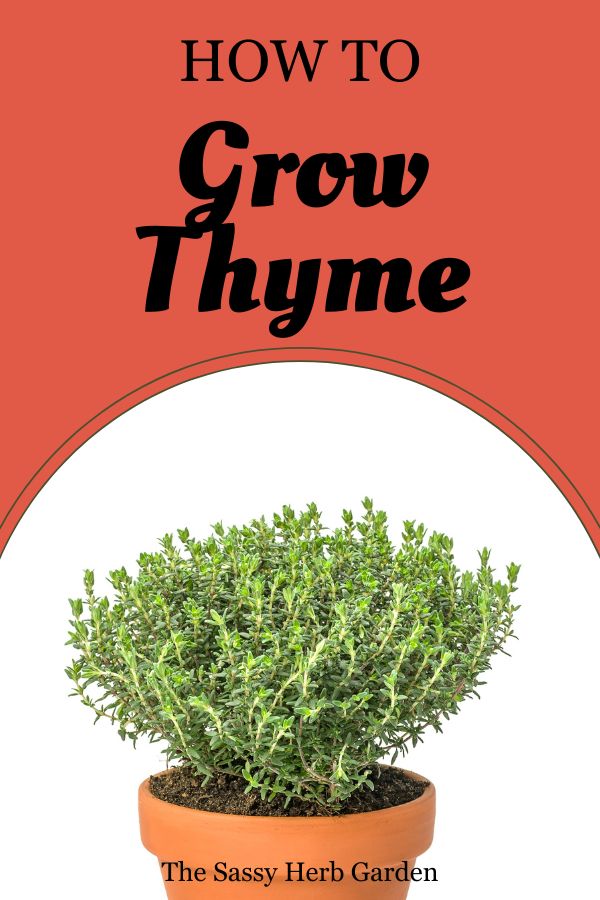If you are looking for a touch of aromatic bliss in your garden, then growing thyme is an excellent choice. It’s perfect for elevating your culinary creations or simply enjoying the lush greenery. Thyme is known for its distinctive scent and delicious taste. In this complete guide on how to grow thyme, we walk you through the simple process of cultivating your very own thyme plants.
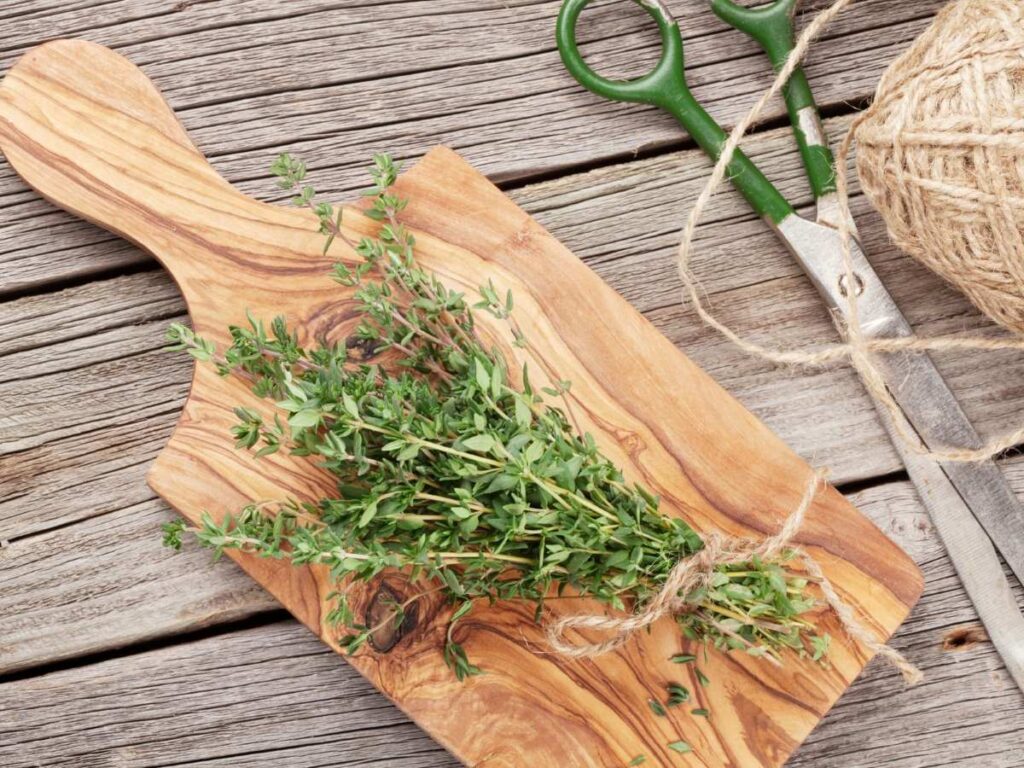
Thymes flavor enhances a wide range of dishes, such as soups, sauces, and meats. In the garden, thyme also attracts pollinators, bees and butterflies. This herb originates from the Mediterranean region, where it thrives in full sunlight and well-draining soil. As a drought-tolerant herb, thyme is relatively low-maintenance and can withstand various climates.
Benefits and Uses for Thyme
- Thyme is a hardy herb that grows well in a variety of climates, making it one of the most popular plants in herb gardens. I find thyme to be very easy to grow and maintain. It is a very hardy perennial, coming back year over year through zone 5, that loves sunny, well-drained locations.
- Because thyme doesn’t lose its flavor when cooking for a long period it is a flavorful addition to soups, stews, and casseroles. It also pairs well in recipes with other Mediterranean herbs like rosemary, oregano, and basil.
- As a low-growing, 6-12 inches tall, woody herb thyme is a delightful addition to your landscape. The small spreading bush-like plants have a gorgeous dark green leaf with tiny white to lavender flower clusters. Low-growing varieties are great for rock gardens.
- Thyme also has natural anti-bacterial properties so is often used in making fragrant soaps.
- With nectar-filled flowers, thyme is a great addition for a butterfly garden.
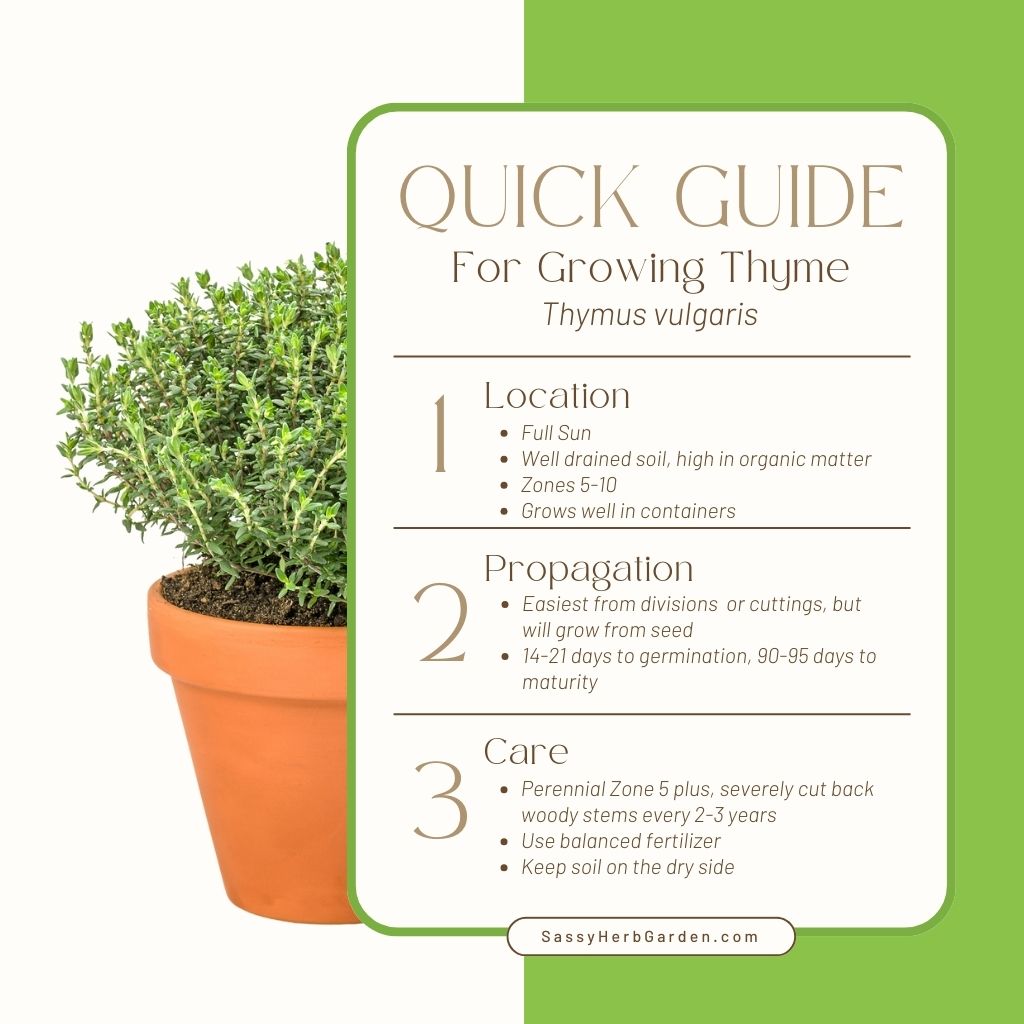
Growing Thyme: Getting Started
Thyme is easiest to start growing from cuttings or root divisions. You can also grow it from seed, but you’ll need a lot of patience as thyme is slow to germinate, just as we discovered with rosemary seeds. However, if you want to grow a unique variety, beginning with seeds is often the only way. If you are a beginning herb gardener you might find it easier to start with nursery-grown plants.
Propagating Thyme from Root Divisions
As a hardy perennial through zone 5, thyme comes back year after year as long as it is planted in well-drained soil. It also loves to be dug up and the roots split every 2-3 years. That means you can quickly expand the number of thyme plants you have in your garden each year with the extra root divisions.
- Select a mature plant: Thyme is best divided every 2-3 years.
- Wait for the right time: Divide thyme plants in spring or early autumn so divisions have time to establish themselves before extreme temperatures set in.
- Dig up the plant: Carefully dig up the plant using a garden fork or a spade, keeping the root system intact.
- Divide the plant: Gently pull apart the thyme’s root ball into 3 to 4 sections. I’ve also used a sharp knife or a small pruning saw to cut through the roots. Each division should have a good amount of roots and foliage.
- Replant divisions: Plant one division in the original spot, adding a lot of fresh organic matter. Then plant the other divisions into well-drained soil in their new location or pots containing potting mix. Water them well and continue to care for them as mature thyme plants.
Growing Thyme from Cuttings: Step by Step
Thyme starts from cuttings fairly easily. Rooting cuttings in soil seems to be the most popular method, but thyme also easily roots hydroponically.
- Choose a healthy plant: Choose stems that are actively growing for the best results. Once thyme hardens off with cold fall weather it is much more difficult to root.
- Take cuttings: In early summer, take cuttings that are about 3 inches long from the plant’s soft tips. Remove the lower leaves from the cutting, leaving only a few at the top.
- Plant cuttings: Plant the cuttings in containers filled with well-draining soil. Keep them in a bright area with indirect sunlight, and maintain a consistent temperatures of around 70°F.
- Monitor growth: Rooting may take a few weeks. Once you notice new growth on the cuttings, you can transplant them to a sunny spot in your garden or a pot.
Growing Thyme from Seed: Step by Step
- Stratify Seeds: Place seeds in the freezer about a month before planting to improve germination.
- Start indoors: Germination time for thyme seeds can vary with conditions, usually taking 14-21 days to sprout.
- Choose the right soil: Thyme prefers soil that is not overly rich or moist. Make sure to use well-draining soil. Over wet soil is the biggest cause of seed germination failure.
- Plant seeds: Sow thyme seeds on the surface of the soil, and lightly cover them with a thin layer of soil or compost.
- Light and temperature: Place the seedlings near a window with full sun or use grow lights. Keep the temperature consistent, ideally around 70°F. The seeds will not germinate well at cool temperatures.
- Transplant: Once the seedlings have at least two sets of true leaves and the last frost has passed, you can transplant them to your garden or a large container. If planting in the ground, space them about 9 to 12 inches apart.

Selecting Thyme Plants from your local Garden Center
Buying thyme plants from a local garden center can save you time and simplify the growing process. When selecting plants, choose healthy ones with vibrant green leaves and strong stems.
Planting Thyme in the Garden
Choosing the Right Soil and Location
When planting thyme, the right soil and location are critical for optimal growth. Thyme thrives in well-draining soil with a pH of 6.0 to 8.0. Its roots like to be on the dry side, so thyme also does well in rocky and sandy soils. It needs full sunlight for at least six to eight hours daily to ensure healthy growth.
Planting and Transplanting Thyme
Even though it is a perennial that can withstand cold winters, it is best to wait until after the last frost for your area to transplant thyme. Those little plants have been enjoying a warm location until now, so there is no need to risk putting them into shock by planting too early.
Growing Thyme in Pots
Thyme thrives in containers, making it perfect for your patio or deck garden. It also grows well in a kitchen window as long as you have bright sunlight. Let’s look at the basics of selecting the right potting soil and the best pots for successfully growing thyme.
Selecting Potting Soil
When it comes to choosing potting soil for your thyme, well-draining soil is a must as thyme doesn’t tolerate overly wet conditions. You can start with a high-quality, store-bought potting mix that contains perlite, or vermiculite for improved drainage. Avoid using heavy potting soils, as they tend to hold onto water excessively.
Best Pots to Grow Thyme
Thyme plants typically grow between 3-12 inches tall and 12-15 inches wide, depending on the variety. Therefore, it’s essential to choose a pot that will accommodate its growth habit. Consider the following when selecting the best pot for your thyme:
- Size: Opt for a pot with a minimum diameter of 12-15 inches to allow your thyme plant to grow and spread comfortably.
- Drainage: Choose a pot with draining holes to prevent the soil from becoming waterlogged. It’s a good idea to add drainage material inside the pot to ensure water drains quickly. I often use the small plastic pots, left over from my annuals, turned upside down in the bottom of large pots for drainage because they don’t add more weight.
- Material: Thyme can grow well in a variety of pot materials, such as terracotta, ceramic, or plastic. Keep in mind that terracotta pots tend to dry out more quickly, so you’ll need to monitor the soil moisture level closely.
Put your pots in an area that gets plenty of sunlight to ensure your thyme is healthy. Use a light fertilizer early-summer to encourage new growth.
Thyme will grow year-round in pots in southern climates. In zones 5-8, the pots can be brought inside to over winter. Or you can overwinter in a protected place, like your garage, that is protected from extreme cold.
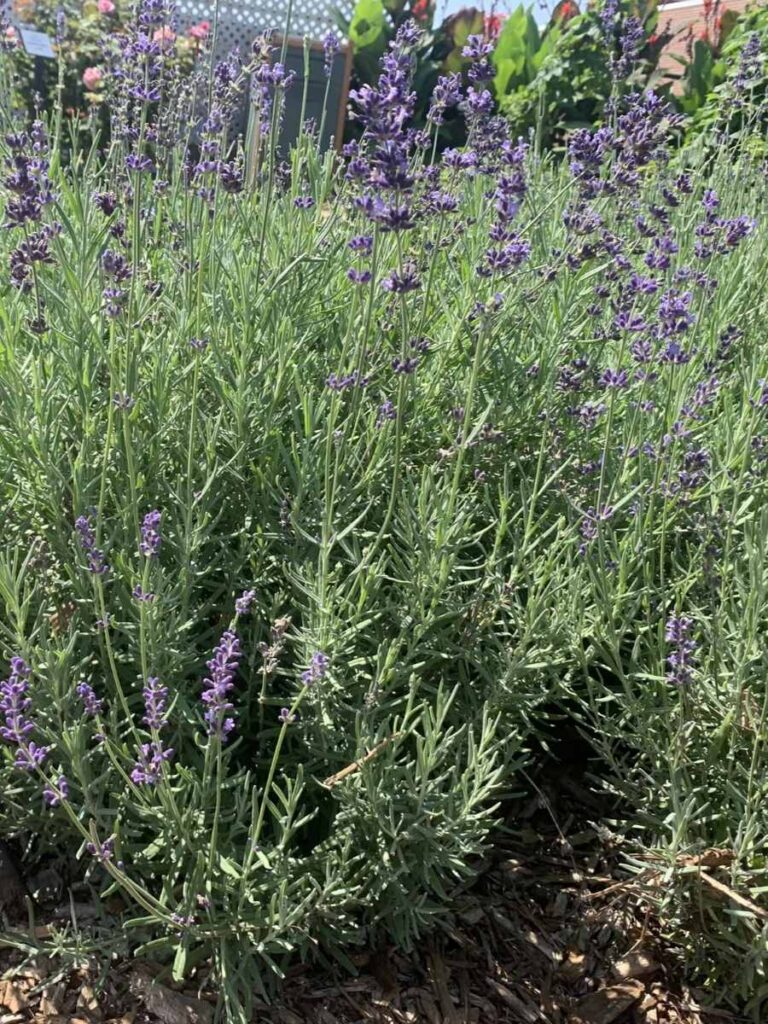
Caring for Thyme
Watering
Thyme prefers a well-draining environment, so it’s essential to allow the soil to dry completely between watering. Water your thyme about once a week in average conditions.
Fertilizing and Composting
Thyme is not a heavy feeder and is rather adaptable to different soil types, including poor soils. A light application of a balanced, all-purpose fertilizer in the spring or early summer should be sufficient for the entire growing season.
Pruning and Encouraging New Growth on Thyme Plants
Regular pruning is crucial for maintaining the shape of your thyme plant and encouraging new growth.
- In the spring, prune your thyme plant to shape it and remove any dead stems to enhance airflow.
- During the summer months, remove any flowers that appear to redirect the plant’s energy into foliage growth. Also, pinching back the tips of the stems will help promote bushier growth, providing more leaves for harvesting.
- In the fall, avoid trimming the plant too much, so the leaves can continue to feed the roots until the plant goes dormant for the winter.
Thyme thrives with a simple care routine. Feel free to prune away to use it as a fresh herb throughout the summer.
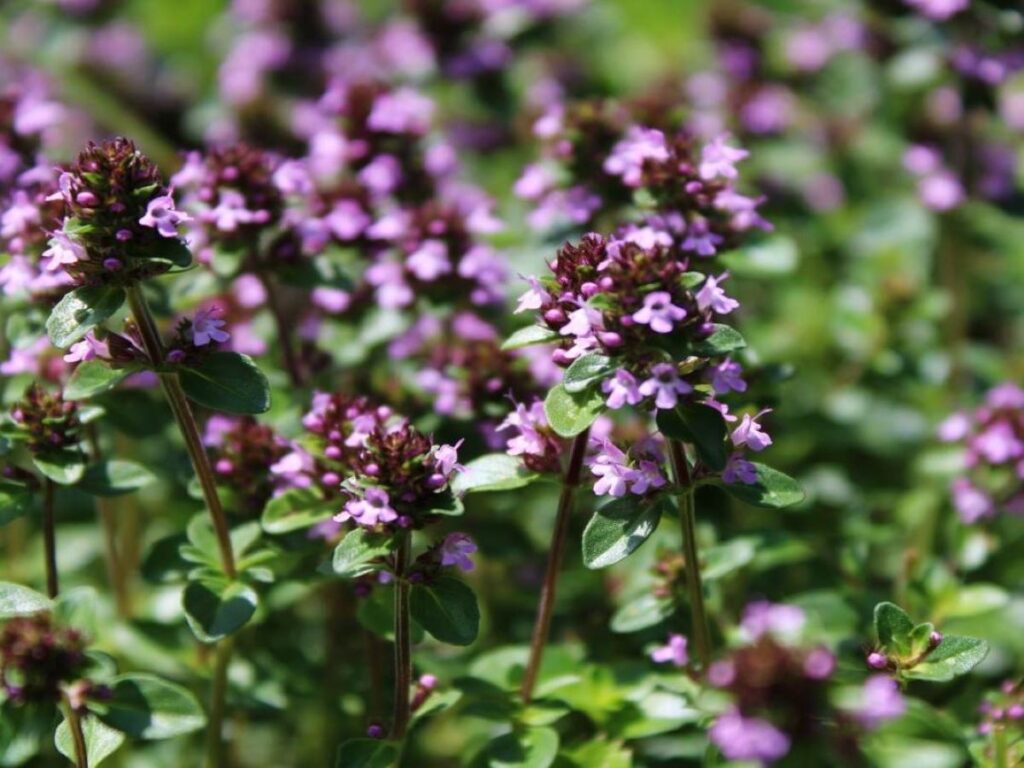
Common Problems and Solutions
Thyme is a very hardy perennial and rarely has problems with pests and diseases. In the rare case that you notice a problem, then it’s likely one of these culprits.
Dealing with Pests
Occasionally, when growing thyme, you may have to deal with pests such as aphids and spider mites. To prevent and treat these infestations, follow these steps:
- Inspect your plants regularly: Keep an eye out for signs of pests like discolored leaves, sticky residue, or webs.
- Prune infested parts: If you find any pests or signs of infestation, remove the affected parts of the plant promptly.
- Use insecticidal soap or horticultural oil: Applying these products to the affected areas of your thyme will help control the pests.
- Encourage beneficial insects: Placing plants such as marigolds or dill near your thyme can attract insects that feed on pests like aphids and spider mites.
- Avoid over-watering: Excess water can create an environment that encourages pests to thrive.
Diseases
Root rot and associated fungal diseases are the biggest challenges with thyme. It’s usually a result of overwatering or planting in a wet spot. Here are a few helpful tips:
- Good air circulation: Thyme plants need airflow around them to prevent the growth of fungi and bacteria. Space your plants at least 12 inches apart and avoid crowding.
- Use well-draining soil: Make sure that your soil drains well, as soggy soil can lead to root rot and other fungal problems. Don’t plant thyme in low-lying aeas that tend to stay wet after a rain. You can always dig up your plant and move it to a drier location.
- Remove affected plant material: If you notice signs of disease on your plants, remove the affected parts and dispose of them properly.
- Treat with fungicides: If diseases persist despite your best efforts, you can turn to organic fungicides to help control the issue. If you plan to use your thyme for cooking avoid chemical solutions.
By keeping an eye on your thyme plants and following these steps, you’ll be on your way to maintaining a healthy, thriving herb garden. Remember, prevention is always the best strategy when it comes to pests and diseases. Happy gardening!
Harvesting and Storing Thyme
When and How to Harvest
Thyme benefits from the same best practices in harvesting as most herbs.
- It’s best to harvest it right before the plant flowers as the blooms will pull the plant nutrients out of the leaves to support flower development.
- The optimal time of day to harvest thyme is on a sunny morning after any dew or moisture has dried. This is when the thyme will be its most fragrant.
- To harvest your growing thyme, simply trim off the top 5-8 inches of growth, leaving the tough and woody parts behind. Make sure to leave at least 4-5 inches of growth behind so your plants can bounce back.
Following this method, you should be able to get 2-3 harvests off the same plants before winter.
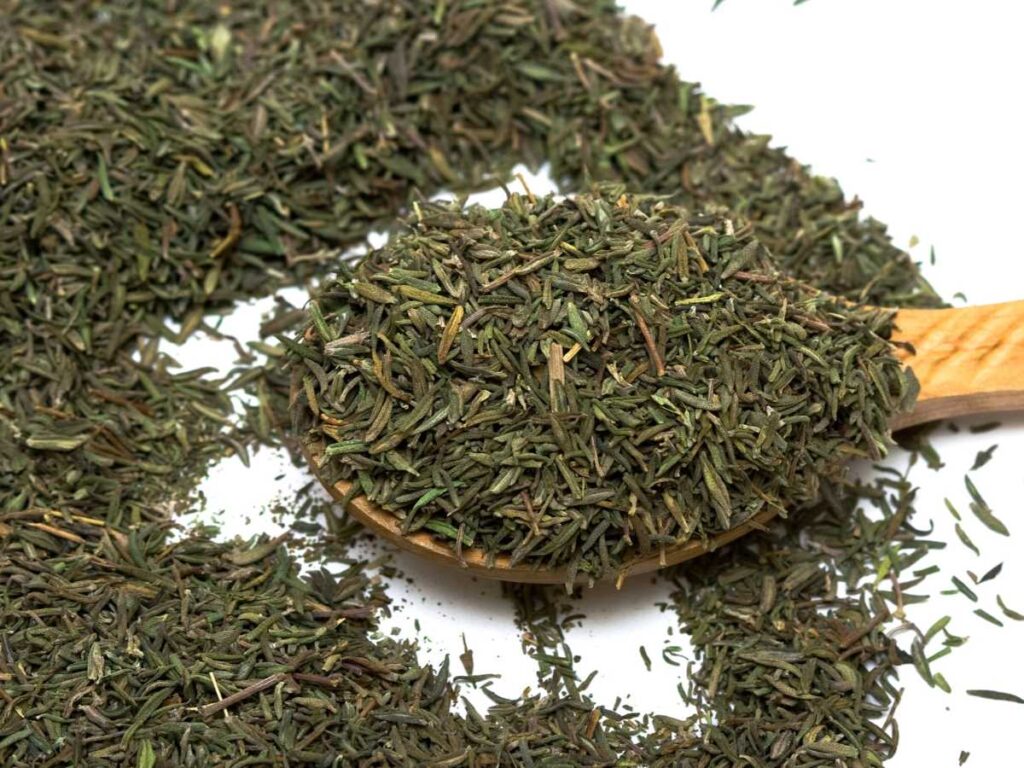
Drying and Storing Fresh Thyme
After harvesting, there are a few ways to store your thyme for later use.
One common method is drying: Tie thyme stems in small bundles and hang them in a well-ventilated area away from direct sunlight. Let them dry for a few days. Once they are dry, remove the leaves from the stems and store them in an airtight container.
Freezing your fresh thyme is another option. To do this, simply remove the leaves from the stems, wrap them in plastic wrap or a freezer bag, and store them in the freezer. This method helps to retain more of the thyme’s aroma compared to drying.

Popular Thyme Varieties
Creeping thyme (Thymus serpyllum) is a low-growing, ground-cover variety that can be a beautiful addition to your garden. This hardy plant can quickly spread, making it perfect for filling in spaces between pavers or as a border along pathways.
Garden thyme (Thymus vulgaris, also known as common thyme) is a versatile variety that is widely used in cooking. It’s a low-growing, woody perennial with a pungent, clover-like flavor that complements many Mediterranean dishes.
Lemon thyme (Thymus citriodorus) is a refreshing variety that, as the name suggests, has a lemony aroma and flavor. This fragrant plant is perfect for adding a zesty twist to your recipes, especially in fish and chicken dishes.
English thyme (Thymus vulgaris ‘English’) is a cultivar of the garden thyme and known for its strong flavor and aromatic scent. This variety is highly valued in culinary preparations, lending its taste to roasted meats, vegetables, and soups.
Companion Planting
When planning your garden consider companion planting to maximize the efficiency and well-being of your plants. Thyme is a versatile companion for many areas of the garden.
Pairing Thyme with Vegetables
Thyme pairs well with several vegetables.
- Plant thyme near cabbage family crops to deter worms and help protect these plants.
- Grow eggplant alongside thyme. Thyme attracts pollinators, which can help increase yields for your eggplants. Keep in mind that eggplants are cold-sensitive and require warm temperatures. And eggplants may need more water than thyme.
- Thyme also grows well near potatoes repelling pests that typically target potato plants.
Complementing Other Herbs
Thyme not only enhances the flavors of your soups and other culinary dishes but also complements the growth of other herbs in your garden. When selecting herbs to grow with thyme, consider the height, growth habits, and preferred conditions of each plant.
- Many Mediterranean herbs like rosemary and English lavender are similar growth requirements with thyme, making them ideal companions.
- Caraway, often used in bread and pastries, is another excellent companion for thyme due to similar height and growth habits.

Culinary Uses for Thyme
Here are some different ways to use thyme in your cooking:
- Sprinkle fresh or dried thyme over roasted vegetables for a fragrant finish.
- Add a few sprigs to your favorite soup or stew recipe for an extra layer of flavor.
- Incorporate thyme into marinades to give proteins like chicken or fish a Mediterranean twist.
- Create delicious herb-infused oils or vinegar by steeping thyme in your choice of oil or vinegar for a few weeks.
Don’t be afraid to experiment with different varieties of thyme in your cooking. Lemon thyme, for example, adds a lovely citrus note to dishes, while English thyme provides a classic, earthy flavor.
Frequently Asked Questions
Yes, thyme is relatively easy to grow for both beginners and experienced gardeners. This hardy perennial herb typically thrives in somewhat dry, sunny conditions. It is low-maintenance and doesn’t demand too much attention, making it a great addition to your garden.
Thyme prefers well-draining soil, commonly found in its native Mediterranean region. A mixture of sandy or rocky soil with a pH range of 6.0 to 8.0 is ideal. You might want to add organic matter or sand to improve the soil’s drainage if needed.
Thyme loves sunlight and requires at least 6 hours of direct sunlight per day. Make sure you plant your thyme in a spot where it gets enough sun, so it can grow healthy and strong. Partial shade is tolerable, but remember, the more sun exposure it gets, the better your thyme will thrive.
Both options are suitable for growing thyme, depending on your preference and available space. In-ground planting allows the plants to spread, while container planting offers portability and enables you to control the growing conditions more easily. If you live in an area with colder winters, planting in pots may be advantageous, as you can bring them inside during extreme weather conditions.
Thyme is a relatively slow-growing herb, taking several months to reach maturity. Generally, it takes about 85 to 95 days from planting the seeds to harvesting the leaves. However, the wait is worth it, as thyme is a lush, aromatic, and flavorful herb that can enhance various dishes and provide numerous health benefits.
With this guide to growing thyme, you’re all set to grow this herb in your garden or your kitchen window. You’ll be the envy of the neighborhood. Remember, patience is key and a little TLC goes a long way. Keep watering, snipping, and basking in the delightful scent of your thriving thyme. Before you know it, you’ll be savoring the taste of your gardening success. Happy growing!

